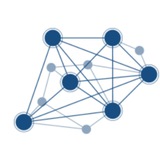🎞 Machine Learning with Graphs: Generative Models for Graphs
💥Free recorded course by Jure Leskovec, Computer Science, PhD
💥In this lecture, we will cover generative models for graphs. The goal of generative models for graphs is to generate synthetic graphs which are similar to given example graphs. Graph generation is important as it can offer insight on the formulation process of graphs, which is crucial for predictions, simulations and anomaly detections on graphs. In the first part, we will introduce the properties of real-world graphs, where a successful graph generative model should fit these properties. These graph statistics include degree distribution, clustering coefficient, connected components and path length.
📽 Watch
📲Channel: @ComplexNetworkAnalysis
#video #course #Graph #Machine_Learning #Generative_Models
💥Free recorded course by Jure Leskovec, Computer Science, PhD
💥In this lecture, we will cover generative models for graphs. The goal of generative models for graphs is to generate synthetic graphs which are similar to given example graphs. Graph generation is important as it can offer insight on the formulation process of graphs, which is crucial for predictions, simulations and anomaly detections on graphs. In the first part, we will introduce the properties of real-world graphs, where a successful graph generative model should fit these properties. These graph statistics include degree distribution, clustering coefficient, connected components and path length.
📽 Watch
📲Channel: @ComplexNetworkAnalysis
#video #course #Graph #Machine_Learning #Generative_Models
YouTube
Stanford CS224W: Machine Learning with Graphs | 2021 | Lecture 14.1 - Generative Models for Graphs
For more information about Stanford’s Artificial Intelligence professional and graduate programs, visit: https://stanford.io/3jO8OsE
Jure Leskovec
Computer Science, PhD
In this lecture, we will cover generative models for graphs. The goal of generative…
Jure Leskovec
Computer Science, PhD
In this lecture, we will cover generative models for graphs. The goal of generative…
👍6
